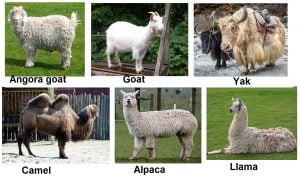Class 7 Chapter 3 Activity
NCERT Science Class 7 Chapter 3 Class 7 Fibre to Fabric Activity Answers
Activity 3.1
Activity 3.1 asks us to feel and compare the hairs present on our head and skin.
Observation: We feel body hairs are softer than hairs on our head.
Answer: Hairs in different regions of our body are different. Our head and facial hairs are much harder than the hairs which grow on other parts. As a result, we feel different when we touch body hair and compare it with hairs on the head.
Activity 3.2
Activity 3.2 asks us to collect pictures of animals that we use to get wool.
Answer: We get wools from various animals. Most of them are from cold regions where lush growth of hairs protects them from the cold. Typical examples are yak, sheep, goats, llama, alpaca, etc. Some animals from the desert also have thick hairs like a camel. In deserts temperature in night drops tremendously. Here, hairs protect animals from chilling nights.
Llama: It is a social and intelligent animal, who lives in a herd. It belongs mainly to South America. Their wool is very soft.
Alpaca: Alpaca is also a native of South America. It looks like Llama, but it is smaller than that.

Activity 3.3
Activity 3.3 asks us to outline the places on the map, where we can see animals with wool.
Answer: Animals with wools are mainly present in the northern hilly mountainous region where the temperature is low throughout the year. Some typical examples are Kashmiri goat of Kashmir, yak of Himachal Pradesh; Sheep are found throughout the country. Below is the map of India with the location of fur animals.
Activity 3.4
Activity 3.4 asks us to debate whether shearing a sheep to get wool is good or bad?
Answer:
Since ancient times people tame and keep the herd of sheep for its wool. Sheep is now a domesticated animal. Many of the sheep become accustomed to the chopping off their hairs once they know it doe not harm them. Chopping helps them get rid of extra wool which is not useful in summer. It also helps them get rid of the dirty materials which stick to their wool.
But many times improper handling of sheep results in cuts and bruises. These cuts and bruises lead to infection in them. Woolen industries sometimes chop hair more frequently to get more wool. This lead to cold in sheep. So, my opinion is that chopping hairs of sheep are not harmful but it should be done carefully and not frequently.
Activity 3.5
Activity 3.5 asks us to collect various types of silk from the tailor shop or home.
Answer:
Silk is the fibers that we get from a silkworm. We can obtain multiple varieties of silk cloth pieces from the local tailor or home. These are:
Mulberry silk: These silks are very soft and shiny silks. We use them as a pillow cover and some curtains.
Tassar silk: Tassar silk is yellow-brown silk. We use them in making silk sarees.
Eri silk: Eri silks are strong fibers and have thermal properties. So we use them with wools in making winter clothes.
Mooga silk: These silks are durable and glossy. They are mostly grown in Assam. They find its use in making silk sarees.
See also:
***Class 7 Chapter 3 Activity***
NCERT Science Class 7 Chapter 3 Class 7 Fibre to Fabric Activity Answers
Ref: Book.
Where’s activity 3.3 world map?
More then 3 activities are not here
Balance 3 activity answer is not there
3 less activities
Please give paheli boojho answers for this chapter
Very Nice Excellent